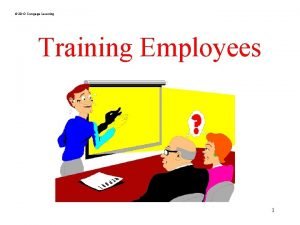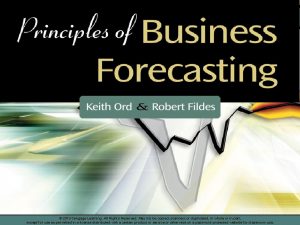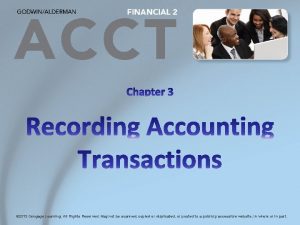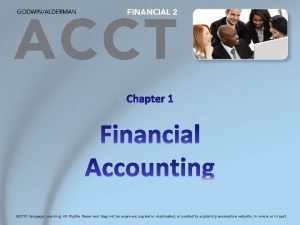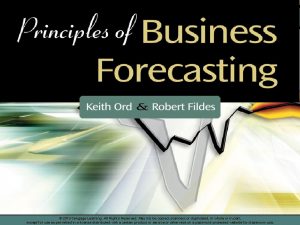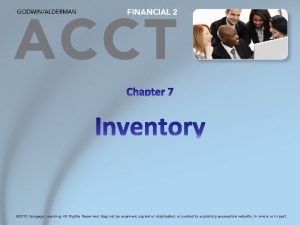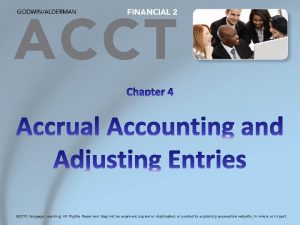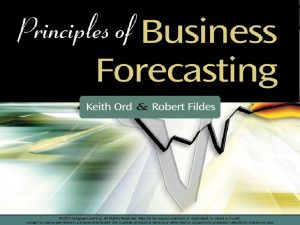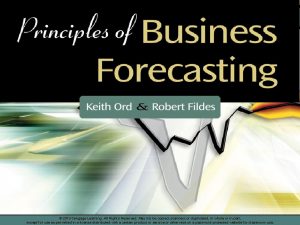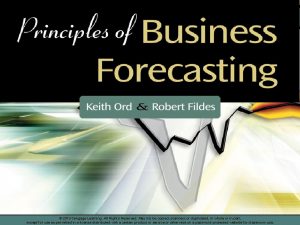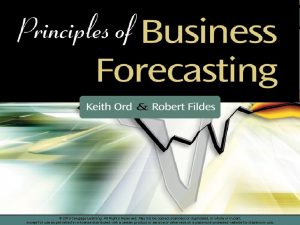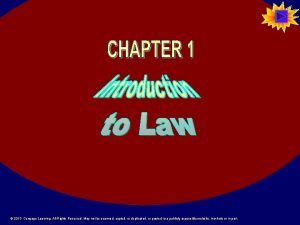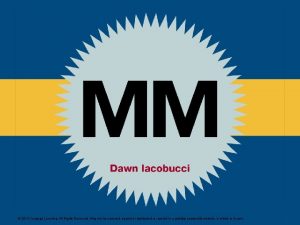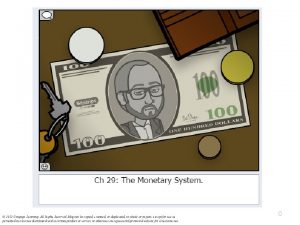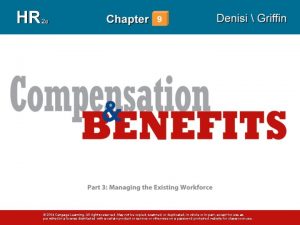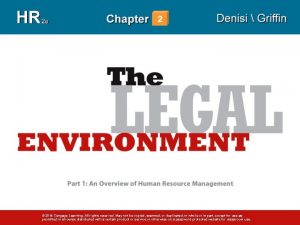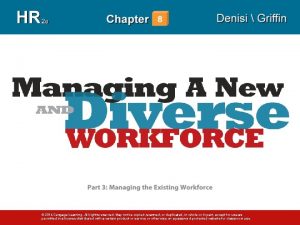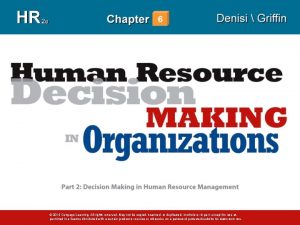2013 Cengage Learning All Rights Reserved May not



































- Slides: 35

© 2013 Cengage Learning. All Rights Reserved. May not be copied, scanned, or duplicated, in whole or in part, except for use as permitted in a license distributed with a certain product or service or otherwise on a password-protected website for classroom use.

Chapter 1: Forecasting, the Why and the How 1. 1 Why Forecast? 1. 2 What and Why Do Organizations Forecast? 1. 3 Examples of Forecasting Problems 1. 4 How to Forecast 1. 5 Forecasting Step by Step 1. 6 Computer Packages for Forecasting 1. 7 Data Sources 1. 8 The Rest of the Book 2 © 2013 Cengage Learning. All Rights Reserved. May not be copied, scanned, or duplicated, in whole or in part, except for use as permitted in a license distributed with a certain product or service or otherwise on a password-protected website for classroom use.

Introduction Forecasting • A forecast: A prediction or estimate of an actual outcome expected in a future time period or for another situation. • The purpose of forecasting is to inform the process of planning. • The purpose of planning is to develop a course of action so that things don’t “just happen” based on a no-change forecast. 3 © 2013 Cengage Learning. All Rights Reserved. May not be copied, scanned, or duplicated, in whole or in part, except for use as permitted in a license distributed with a certain product or service or otherwise on a password-protected website for classroom use.

Discussion Question • What other forecasts are regularly included in the daily newspapers, such as the Wall Street Journal, the New York Times, or the Times of London? 4 © 2013 Cengage Learning. All Rights Reserved. May not be copied, scanned, or duplicated, in whole or in part, except for use as permitted in a license distributed with a certain product or service or otherwise on a password-protected website for classroom use.

1. 1: Why Forecast? • Purpose: What do we hope to achieve by generating the forecast? That is, what plans are dependent upon the results of the forecasting exercise? • Horizon: How far ahead do we wish to forecast? We refer to this period as the forecasting horizon – how far we wish to see ahead. • Information: What do we know and when will we know it? Detailed information is only useful if it is available in timely fashion. • Value: How valuable is the forecast? What would you pay to have perfect knowledge of the future event? • Evaluation: How do we know whether a particular forecasting exercise was effective? 5 © 2013 Cengage Learning. All Rights Reserved. May not be copied, scanned, or duplicated, in whole or in part, except for use as permitted in a license distributed with a certain product or service or otherwise on a password-protected website for classroom use.

1. 1: Why Forecast? 6 © 2013 Cengage Learning. All Rights Reserved. May not be copied, scanned, or duplicated, in whole or in part, except for use as permitted in a license distributed with a certain product or service or otherwise on a password-protected website for classroom use.

1. 2: What and Why Do Organizations Forecast? Forecasts • Brainstorm o What do organizations need to forecast? o What are the “tough!” problems? Plans 7 © 2013 Cengage Learning. All Rights Reserved. May not be copied, scanned, or duplicated, in whole or in part, except for use as permitted in a license distributed with a certain product or service or otherwise on a password-protected website for classroom use.

1. 2: What and Why Do Organizations Forecast? • Costs o raw materials o semi-finished goods o wage rates & overheads o interest rates • Sales/ Activities o by industry o by region o by market/product (market share) o by product category, by wholesaler, by retailer o new product sales o competitive position - e. g. prices, exchange rates o competitive behavior o customer service • • o prices o competitor activities Technology o new products o new processes o diffusion rates Social and Political trends o demographics o wealth profile o welfare and health provisions o impact of technology Projects o duration o costs o life cycle maintenance … 8 © 2013 Cengage Learning. All Rights Reserved. May not be copied, scanned, or duplicated, in whole or in part, except for use as permitted in a license distributed with a certain product or service or otherwise on a password-protected website for classroom use.

1. 2: What and Why Do Organizations Forecast? 9 © 2013 Cengage Learning. All Rights Reserved. May not be copied, scanned, or duplicated, in whole or in part, except for use as permitted in a license distributed with a certain product or service or otherwise on a password-protected website for classroom use.

1. 2: What and Why Do Organizations Forecast? • FORECASTING HORIZONS o Short term § usually few days or weeks o Medium term Depends on the Problem Area § usually a few months to 1 or 2 years o Long term § usually more than 2 years 10 © 2013 Cengage Learning. All Rights Reserved. May not be copied, scanned, or duplicated, in whole or in part, except for use as permitted in a license distributed with a certain product or service or otherwise on a password-protected website for classroom use.

Discussion Question • What type of organizations have the shortest forecasting horizons? • Which have the longest? 11 © 2013 Cengage Learning. All Rights Reserved. May not be copied, scanned, or duplicated, in whole or in part, except for use as permitted in a license distributed with a certain product or service or otherwise on a password-protected website for classroom use.

1. 2: What and Why Do Organizations Forecast? • Forecasting Problem Structure o Forecasting object § Level of aggregation § For a period, cumulative across periods, growth rate, event o Forecasting horizon § How far into the future? o Forecasting Frequency § Yearly Monthly Weekly Daily Within Day … • Structure derived from decision making process. • Forecasts required to support planning & decision making. 12 © 2013 Cengage Learning. All Rights Reserved. May not be copied, scanned, or duplicated, in whole or in part, except for use as permitted in a license distributed with a certain product or service or otherwise on a password-protected website for classroom use.

Discussion Questions • Forecasting state revenues using monthly time series data uncovered a two–year cycle in the data; why might this be? • What might a nuclear electricity supplier or a water company need to forecast with regard to its key assets? Why? • A state or national government provides unemployment benefits for a period of six months following a layoff (or leaving school). It continues for a further six months if the applicant attends a job training program. What variables would the government need to forecast for its annual planning? 13 © 2013 Cengage Learning. All Rights Reserved. May not be copied, scanned, or duplicated, in whole or in part, except for use as permitted in a license distributed with a certain product or service or otherwise on a password-protected website for classroom use.

1. 3: Examples of Forecasting Problems Time Series • A time series is a set of observations ordered in time. • The values may refer to either a point in time (the current value of the Dow Jones Index is 13, 000) or an aggregate over a period of time (total sales for the last month were 350 units). • Typically, we assume that the observations are equally spaced in time. How might we deal with irregular spacing such as stock markets closing at weekends or monthly sales? 14 © 2013 Cengage Learning. All Rights Reserved. May not be copied, scanned, or duplicated, in whole or in part, except for use as permitted in a license distributed with a certain product or service or otherwise on a password-protected website for classroom use.

Figure 1. 2: U. S. Monthly Retail Sales and Food Services, measured in millions of current dollars. Source: U. S. Census Bureau via Econstats, www. econstats. com/retsal_m 1. htm. Data shown is from file US_retail_sales. xlsx. © 2013 Cengage Learning. All Rights Reserved. May not be copied, scanned, or duplicated, in whole or in part, except for use as permitted in a license distributed with a certain product or service or otherwise on a password-protected website for classroom use. 15

Figure 1. 3: Seasonal factors for U. S. Monthly Total Sales for Retail Sales and Food Services Source: U. S. Census Bureau via Econstats, www. econstats. com/retsal_m 1. htm. Data: US_retail_sales. xlsx. © 2013 Cengage Learning. All Rights Reserved. May not be copied, scanned, or duplicated, in whole or in part, except for use as permitted in a license distributed with a certain product or service or otherwise on a password-protected website for classroom use. 16

1. 3: Examples of Forecasting Problems 17 © 2013 Cengage Learning. All Rights Reserved. May not be copied, scanned, or duplicated, in whole or in part, except for use as permitted in a license distributed with a certain product or service or otherwise on a password-protected website for classroom use.

Figure 1. 6: Year-over-year percentage change in U. S. monthly retail sales and food service ©Cengage Learning 2013. © 2013 Cengage Learning. All Rights Reserved. May not be copied, scanned, or duplicated, in whole or in part, except for use as permitted in a license distributed with a certain product or service or otherwise on a password-protected website for classroom use. 18

1. 3: Examples of Forecasting Problems 19 © 2013 Cengage Learning. All Rights Reserved. May not be copied, scanned, or duplicated, in whole or in part, except for use as permitted in a license distributed with a certain product or service or otherwise on a password-protected website for classroom use.

Figure 1. 7: Serious injuries and deaths on U. K. roads, January 1975 – December 1984 Injuries, U. K. road accidents 2400 2150 1900 1650 1400 900 1 3 5 7 9 11 13 15 17 19 21 23 25 27 29 31 33 35 37 39 41 43 45 47 49 51 53 55 57 59 61 63 65 67 69 71 73 75 77 79 81 83 85 87 89 91 93 95 97 99 101 103 105 107 109 111 113 115 117 119 1150 Source: Harvey and Durbin (1986). Data shown is from file Road_accidents. xlsx. Sudden shifts and changes in policy or circumstances can change the basis forecasting. © 2013 Cengage Learning. All Rights Reserved. May not be copied, scanned, or duplicated, in whole or in part, except for use as permitted in a license distributed with a certain product or service or otherwise on a password-protected website for classroom use. 20

1. 3: Examples of Forecasting Problems 21 © 2013 Cengage Learning. All Rights Reserved. May not be copied, scanned, or duplicated, in whole or in part, except for use as permitted in a license distributed with a certain product or service or otherwise on a password-protected website for classroom use.

Discussion Question • How would you estimate the effect of 9/11 [September 11 th 2001] upon the airline industry with respect to losses in passenger miles? 22 © 2013 Cengage Learning. All Rights Reserved. May not be copied, scanned, or duplicated, in whole or in part, except for use as permitted in a license distributed with a certain product or service or otherwise on a password-protected website for classroom use.

Figure 1. 9: Italian soccer club Florence (Fiorentina)’s record : wins (1), draws(0) and losses (-1) – season 2004/5. © Cengage Learning 2013 © 2013 Cengage Learning. All Rights Reserved. May not be copied, scanned, or duplicated, in whole or in part, except for use as permitted in a license distributed with a certain product or service or otherwise on a password-protected website for classroom use. 23

Figure 1. 10: Scatterplot of baseball players’ salaries against the number of years played in the major leagues Source: We wish to acknowledge Stat. Lib of the Department of Statistics at Carnegie Mellon University. Data shown is from file Baseball. xlsx. © 2013 Cengage Learning. All Rights Reserved. May not be copied, scanned, or duplicated, in whole or in part, except for use as permitted in a license distributed with a certain product or service or otherwise on a password-protected website for classroom use. 24

1. 4: How to Forecast 25 © 2013 Cengage Learning. All Rights Reserved. May not be copied, scanned, or duplicated, in whole or in part, except for use as permitted in a license distributed with a certain product or service or otherwise on a password-protected website for classroom use.

1. 5: Forecasting Step by Step 1. Define the forecasting and planning problem, and decide the value of better forecasts. 2. Determine the resources to be devoted to providing the forecasts. 3. Collect relevant data, whether from a survey, from company records, or from information generated by other agencies (e. g. , government figures). 4. Conduct an initial analysis of the data. 5. Select an appropriate forecasting method. 6. Generate forecasts. 7. Validate the forecasting exercise by checking forecasts against actual outcomes. 26 © 2013 Cengage Learning. All Rights Reserved. May not be copied, scanned, or duplicated, in whole or in part, except for use as permitted in a license distributed with a certain product or service or otherwise on a password-protected website for classroom use.

1. 6: Computer Packages for Forecasting • Almost all statistical packages include routines for regression analysis. • Computer software for time series analysis is more variable. • The book uses a variety of software: o Excel (graphs and macros only). o General purpose statistical programs: Minitab, SAS, and SPSS. o Specialized forecasting software: Forecast Pro. o Specialized econometric software: EViews and PCGive. • A brief summary of the capabilities of the major forecasting packages is provided in online Appendix C. 27 © 2013 Cengage Learning. All Rights Reserved. May not be copied, scanned, or duplicated, in whole or in part, except for use as permitted in a license distributed with a certain product or service or otherwise on a password-protected website for classroom use.

1. 7: Data Sources • All U. S. government departments have publicly available websites from which data may be downloaded. For example: o Census Bureau (http: //www. census. gov/). o Bureau of Labor Statistics (http: //www. bls. gov/). • In the United Kingdom, the U. K. National Statistics site provides similar data (http: //www. statistics. gov. uk/hub/index. html). • All major companies have websites from which data on their overall operations can be obtained, although these data are not always packaged in a ready-to-download format. 28 © 2013 Cengage Learning. All Rights Reserved. May not be copied, scanned, or duplicated, in whole or in part, except for use as permitted in a license distributed with a certain product or service or otherwise on a password-protected website for classroom use.

1. 8: The Rest of the Book - 1 • Chapter 2: An overview of the basic statistical tools used in forecasting • Chapters 3 and 4: Forecasting methods for trends and seasonal patterns in single series • Chapters 5 and 6: Underlying state-space and ARIMA models for single series methods • Chapters 7 – 9: Regression methods and related modelbuilding approaches forecasting 29 © 2013 Cengage Learning. All Rights Reserved. May not be copied, scanned, or duplicated, in whole or in part, except for use as permitted in a license distributed with a certain product or service or otherwise on a password-protected website for classroom use.

1. 8: The Rest of the Book - 2 • Chapter 10: Advanced methods forecasting • Chapter 11: The use of judgment in creating and adapting forecasts • Chapters 12 and 13: Putting forecasting methods to work and making sure that forecasting is effective in practice 30 © 2013 Cengage Learning. All Rights Reserved. May not be copied, scanned, or duplicated, in whole or in part, except for use as permitted in a license distributed with a certain product or service or otherwise on a password-protected website for classroom use.

Mini-Case 1. 1: Inventory Planning • The Nuts’n’Bolts hardware stocks some high-value items and a large number of relatively low-value components. Inventory is reviewed weekly, and orders are placed with suppliers when inventory levels indicate that current levels are “too low. ” Most suppliers deliver the low-value items within two weeks; some of the high-value items may take four weeks for delivery. How would you develop a forecasting system to predict the sales of such items at the individual (SKU = stock-keeping unit) level? How would you use such forecasts to plan future purchases? • Use PHIVE to go through the necessary steps. For purposes of the discussion, assume that any historical data you might need can be made available. 31 © 2013 Cengage Learning. All Rights Reserved. May not be copied, scanned, or duplicated, in whole or in part, except for use as permitted in a license distributed with a certain product or service or otherwise on a password-protected website for classroom use.

Mini-Case 1. 2: Long-term Growth • You work for a consulting firm that is bidding on a contract to forecast the growth prospects of an electronics company over the next five years. The company has developed a specialized computer chip that is used in highly sensitive medical equipment and does not anticipate creating any new product lines, although periodic improvements to the chip are anticipated. • Write a short proposal describing how you would develop such forecasts, using PHIVE as a guide. For purposes of the assignment, assume that any historical data you might need can be made available, but describe carefully the nature of the data needed. 32 © 2013 Cengage Learning. All Rights Reserved. May not be copied, scanned, or duplicated, in whole or in part, except for use as permitted in a license distributed with a certain product or service or otherwise on a password-protected website for classroom use.

Mini-Case 1. 3: Sales Forecasting • A company sells many hundreds of clothing products by mail order and through the Internet. The firm also offers the customer four different purchase schemes, from pay on purchase through payment over different periods (of 6 and 12 months). The final plan allows a postponement of any payment for 12 months. • The firm has to ensure a supply of its advertised products to meet forecast demand. Adequate inventory has consequences for the distribution network. (The products need to be stocked and then shipped. ) The retailer also has to decide which customers to target through mailings to stimulate further purchases. • What variables would the company need to forecast? What strategic financial decisions may need to be linked to the various customer purchase plans? Use the PHIVE framework to guide your thinking. 33 © 2013 Cengage Learning. All Rights Reserved. May not be copied, scanned, or duplicated, in whole or in part, except for use as permitted in a license distributed with a certain product or service or otherwise on a password-protected website for classroom use.

Mini-Case 1. 4: Adjusting for Inflation • The data file for U. S. retail sales (US_retail_sales. xlsx) also contains monthly data for the Consumer Price Index (CPI). • Create a series called “real prices” by dividing sales by the CPI; then replicate Figures 1. 2, 1. 4, and 1. 5 for this series. • Compare your results with the three figures provided in the text, commenting on major differences. (Use the same seasonal adjustment factors. ) 34 © 2013 Cengage Learning. All Rights Reserved. May not be copied, scanned, or duplicated, in whole or in part, except for use as permitted in a license distributed with a certain product or service or otherwise on a password-protected website for classroom use.

Take-Aways • Make sure that the forecasting methods used will meet the underlying purpose of the forecasting exercise. • Ensure the method will provide forecasts sufficiently far ahead (the horizon). • Check that the required information will be available at the time the forecasts must be generated. • The resources devoted to the forecasting exercise should be consistent with the value the forecast will provide. • Validate the forecasts (evaluation). 35 © 2013 Cengage Learning. All Rights Reserved. May not be copied, scanned, or duplicated, in whole or in part, except for use as permitted in a license distributed with a certain product or service or otherwise on a password-protected website for classroom use.
 Solomon four group design
Solomon four group design All rights reserved example
All rights reserved example Copyright 2015 all rights reserved
Copyright 2015 all rights reserved All rights reserved sentence
All rights reserved sentence Creative commons vs all rights reserved
Creative commons vs all rights reserved Confidential all rights reserved
Confidential all rights reserved All rights reserved example
All rights reserved example Copyright 2015 all rights reserved
Copyright 2015 all rights reserved 2012 pearson education inc
2012 pearson education inc Microsoft corporation. all rights reserved.
Microsoft corporation. all rights reserved. Microsoft corporation. all rights reserved.
Microsoft corporation. all rights reserved. Microsoft corporation. all rights reserved
Microsoft corporation. all rights reserved Pearson education inc. all rights reserved
Pearson education inc. all rights reserved Dell all rights reserved copyright 2009
Dell all rights reserved copyright 2009 Warning all rights reserved
Warning all rights reserved All rights reserved c
All rights reserved c Quadratic equation cengage
Quadratic equation cengage Warning all rights reserved
Warning all rights reserved Confidential all rights reserved
Confidential all rights reserved Microsoft corporation. all rights reserved
Microsoft corporation. all rights reserved 2010 pearson education inc
2010 pearson education inc Copyright © 2018 all rights reserved
Copyright © 2018 all rights reserved Gssllc
Gssllc Pearson education inc all rights reserved
Pearson education inc all rights reserved Pearson education inc. all rights reserved
Pearson education inc. all rights reserved Confidential all rights reserved
Confidential all rights reserved Airbus deutschland gmbh
Airbus deutschland gmbh R rights reserved
R rights reserved Rights reserved
Rights reserved Hci design patterns
Hci design patterns 2009 delmar cengage learning
2009 delmar cengage learning Chapter 5 the cardiovascular system labeling exercises
Chapter 5 the cardiovascular system labeling exercises Cengage learning heart diagram
Cengage learning heart diagram South-western cengage learning
South-western cengage learning Chapter 13 medical math assignment sheet cengage learning
Chapter 13 medical math assignment sheet cengage learning 2009 delmar cengage learning
2009 delmar cengage learning
